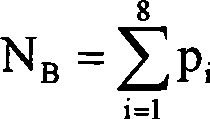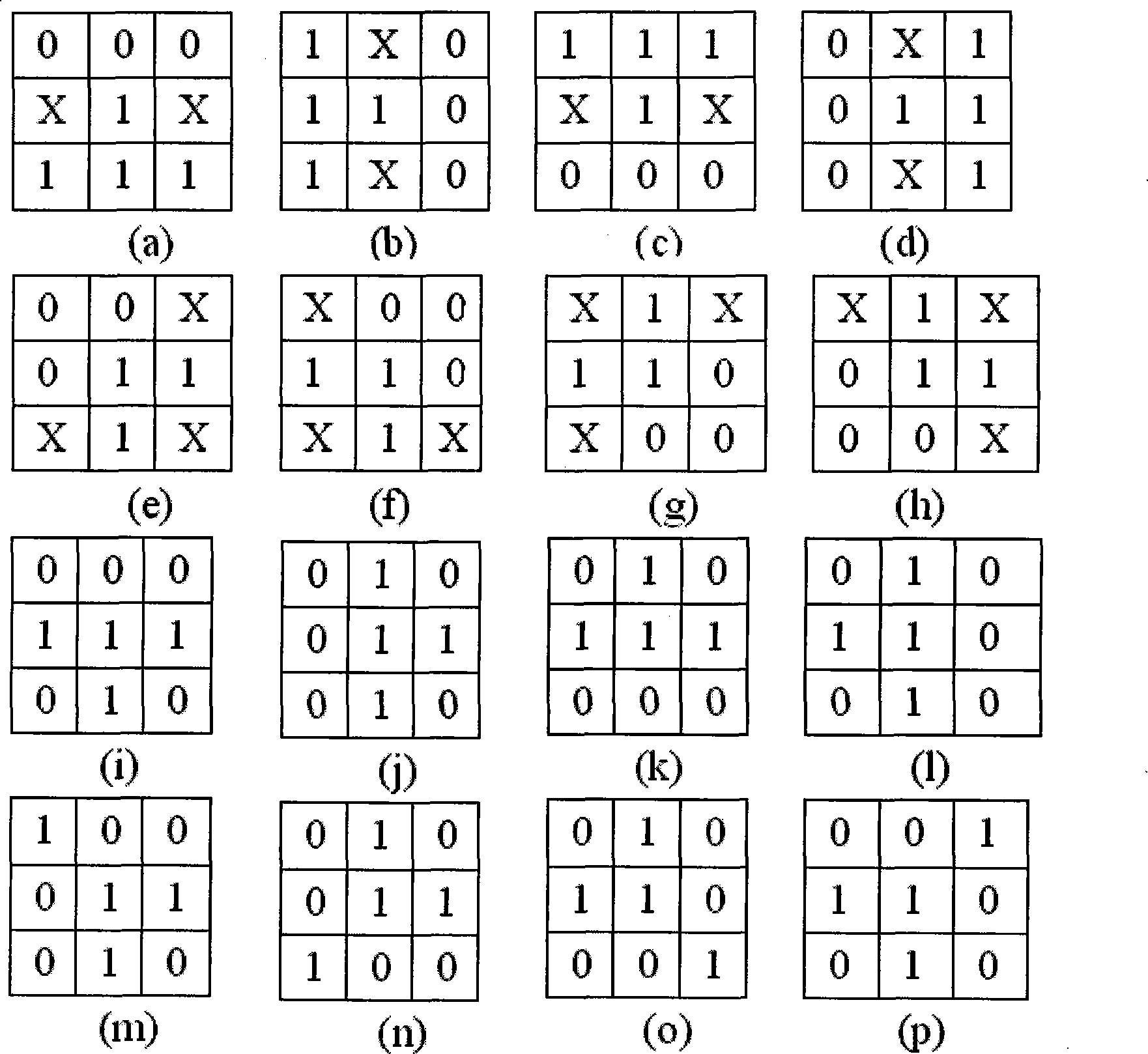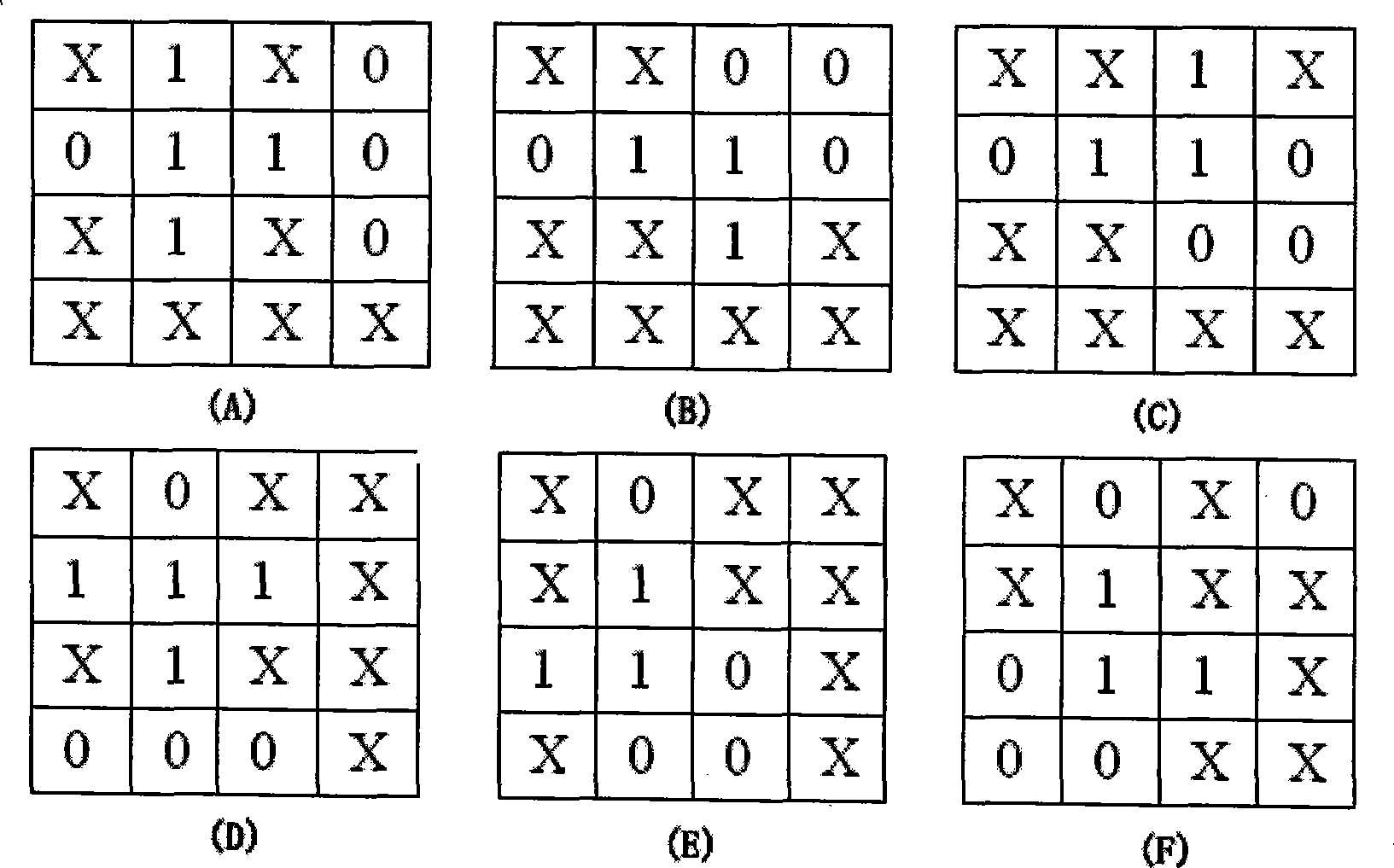Fast highly efficient finger print thinning method
A fast, fingerprint technology, applied in instruments, character and pattern recognition, computer parts and other directions, can solve the problems of not single pixel lines, affecting the accuracy of fingerprint recognition, incomplete refinement, etc., to achieve the effect of improving operating efficiency
- Summary
- Abstract
- Description
- Claims
- Application Information
AI Technical Summary
Problems solved by technology
Method used
Image
Examples
specific Embodiment approach 1
[0008] Specific implementation mode one: this implementation mode consists of the following steps:
[0009] Step A1, fast thinning: first determine the boundary points of the fingerprint lines in the image P to be thinned, and then gradually delete the boundary points of the fingerprint lines to obtain the fast thinning image Q;
[0010] Step A2, OPTA thinning: using the elimination template and the reserved template of the OPTA thinning method, the fast thinning image Q is turned into a single-phase pixel image.
[0011] The method of this embodiment is mainly divided into two parts. The first part is to use the characteristics of the fast thinning method to perform preliminary processing on the image, so as not to directly use the OPTA method to consume more time, and then use the OPTA thinning method to refine the image. The image is thoroughly thinned, which avoids the problem of incomplete image thinning by the fast thinning method, so that the thinned image can better se...
specific Embodiment approach 2
[0012] Specific implementation mode 2: This implementation mode further defines the rapid refinement described in step 1 on the basis of specific implementation mode 1, including the following steps:
[0013] Step B1, construct the following 3×3 neighborhood template for the target point:
[0014] P 8 P 1 P 2 P 7 P 0 P 3 P 6 P 5 P 4
[0015] In the neighborhood of the target point, calculate the number of pixels with a value of 1 in the binarized image N B = Σ i = 1 8 p i and the fraction of connections in the neighborhood T(P 0 );
[0016] Step B2, sequentially scan the image P to be refined, and delete the pixels satisfying the condition TP1 or TP2:
[0017] TP1: center pixel P 0 There are 2-6 eight-connected adjacent pixel points T(P 0 )=1,P 1 P 3 P 5 =...
specific Embodiment approach 3
[0021] Specific implementation mode three: this implementation mode further defines on the basis of specific implementation mode one that the refinement of OPTA described in step one consists of the following steps:
[0022] Step C1, construct the following 16 3×3 elimination templates, where X is an uncertain number, which may be 0 or 1:
[0023]
[0024] Construct the following six 4×4 reserved templates, where X is an uncertain number, which may be 0 or 1:
[0025]
[0026] Construct the following 3 4×4 special templates that need to be discarded among the 6 reserved templates:
[0027]
[0028] Step C2, for the current pixel point Q 0 Extract (from left to right and from top to bottom) 14 adjacent pixels and the current pixel Q 0 Construct the following 4×4 improved OPTA template, where X is an uncertain number, which may be 0 or 1:
[0029] Q 8 Q 1 Q 2 Q 12 Q 7 Q 0 Q 3 Q 13 Q 6 Q 5 Q 4 Q 14 Q 9 Q 10 Q 11 X
...
PUM
 Login to View More
Login to View More Abstract
Description
Claims
Application Information
 Login to View More
Login to View More - R&D
- Intellectual Property
- Life Sciences
- Materials
- Tech Scout
- Unparalleled Data Quality
- Higher Quality Content
- 60% Fewer Hallucinations
Browse by: Latest US Patents, China's latest patents, Technical Efficacy Thesaurus, Application Domain, Technology Topic, Popular Technical Reports.
© 2025 PatSnap. All rights reserved.Legal|Privacy policy|Modern Slavery Act Transparency Statement|Sitemap|About US| Contact US: help@patsnap.com



